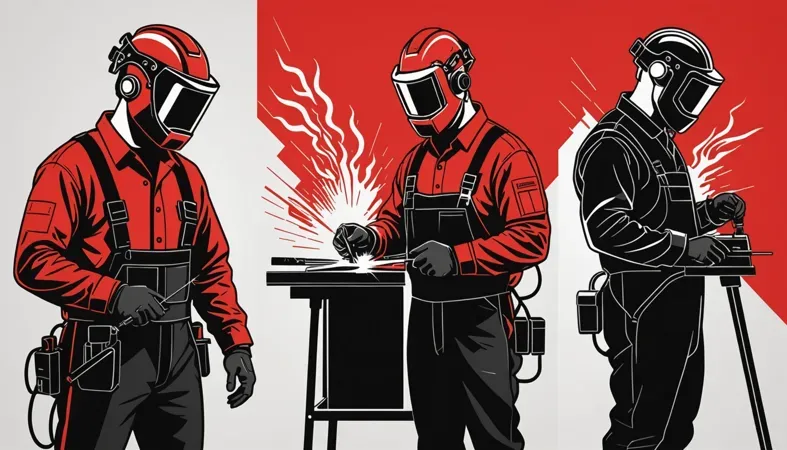How Much is Welding School? Costs, Types, and Enrollment Tips
Published on: May 5, 2025 | Last modified: March 4, 2025
By: Joe Carter
If you thought that going to trade school is expensive, you’re probably wondering how much is welding school? It’s important to get this right, as it affects your budget and future earnings. In my experience, investing in a welding education pays off, with skilled welders often earning a solid income.
In this article, I’ll cover several key topics, including types of welding schools, steps to enroll, safety tips, various training programs, factors influencing costs, troubleshooting common issues, aftercare practices, advantages of welding, real-world applications, and other educational options. If you’ve ever asked yourself how much does welding school cost, this guide’s for you!
Contents
- How Much is Welding School?
- What is Welding School?
- Types Of Welding Schools
- Steps to Enroll in Welding School
- Types Of Welding Training Programs
- Factors Influencing Welding School Costs
- Scholarships and Financial Aid for Welding School
- Common Issues and Troubleshooting
- Why This is Worth It: Advantages
- Real-world Uses for Welding Skills
- Other Options You Can Consider
- Frequently Asked Questions (FAQs)
- Conclusion
- References
How Much is Welding School?
Welding school teaches you the craft of welding. So, how much is welding school? Expect to pay between $3,000 and $30,000 depending on the program and location. It can be tough but leads to great job opportunities.
What is Welding School?
Welding school is a specialized training program that teaches the art and science of welding. These schools offer hands-on instruction in techniques like MIG, TIG, and Stick welding. Welding schools cover essential skills such as blueprint reading and metallurgy. According to the National Center for Education Statistics, the average welding program lasts about 6 to 12 months, depending on the curriculum’s depth and focus. Now, let’s discuss welding school costs. They vary widely, with many programs ranging from $5,000 to $20,000 USD. In my experience, spending around $10,000 USD for quality training at an accredited school was a worthwhile investment for my career. I can’t count how many times I’ve used what I learned in welding school! Every penny spent on my training was worth it. When you’re considering welding schools near you, think about the costs and what you’ll gain—job skills and earning potential after graduation. Remember, investing in your future is priceless!
Types Of Welding Schools
-
Community College Welding Programs
Community colleges offer affordable welding programs, typically costing between $3,000 and $15,000. Check the tuition and fees on the specific college website, like Tennessee Colleges of Applied Technology, plus any materials required for classes.
-
Trade School Welding Programs
Trade schools focus on vocational training in welding, often charging around $10,000 to $30,000. For exact pricing, research programs like Tulsa Welding School and contact them about financial aid options.
-
Online Welding Courses
Online courses offer flexibility for those wanting to learn welding at home, typically ranging from $500 to $5,000. Research accredited online platforms for credible courses and check their full cost breakdown. To dive deeper into expert welding techniques you can explore how to heliarc weld.
-
Apprenticeship Welding Programs
Apprenticeships combine work experience with training and usually pay you while you learn, ranging from $15,000 to $25,000 annually. Check local unions or trade organizations for openings and requirements.
-
Certified Welding Programs
Certified programs prepare you for specific welding certifications, costing between $2,000 and $10,000. To enroll, find schools offering American Welding Society (AWS) certification preparatory courses that align with your career goals.
We have now covered various welding school types. Let’s now take a look at the steps to enroll in welding school.

Steps to Enroll in Welding School
Here are steps to determine how much you can expect to pay for welding school.
-
Research Welding Schools
Start by exploring various welding schools in your area or online. Costs vary significantly—some schools charge between $5,000 and $20,000 for a full program, depending on location and reputation. For instance, a vocational school in Florida might offer a complete program for $10,000, while a well-known school in Texas can cost up to $15,000. Prepare a list of schools and their tuition fees for easy comparison. Use the internet or ask local welders for recommendations. Word-of-mouth often provides insight into quality. Look for schools that offer flexible payment options to ease the financial burden. Schools may advertise limited-time discounts that can reduce your overall costs. As you progress in your welding journey, mastering new techniques, such as how to weld vertical, can enhance your skills and employability.
.
-
Compare Programs and Costs
After gathering school options, compare their programs. Not every program includes the same courses or facilities. For example, some schools might charge $12,000 but offer advanced courses that enhance employability. Competing schools may be worth the extra cost if the coursework better aligns with your career goals.
Look for financial aid, grants, or scholarships. Many schools partner with organizations to help cover costs. Investigate all these options—factor in not just tuition but also equipment fees, supplies, and lab costs, which can add another $1,000 to $3,000.
-
Evaluate Financial Aid Options
Check the financial aid available at each school. Many institutions provide funding opportunities like Pell Grants or state-funded grants. Maximize your aid application to lessen the cost burden. Consider payment plans that let you pay fees over time without accumulating debt.
Some employers offer tuition reimbursement. Explore work-study programs or apprenticeships that might pay for your education while providing valuable experience. Reach out to companies as you research schools; they may invest in your training.
-
Apply and Secure Enrollment
Once you’ve chosen a school, submit your application. Meet all deadlines and provide accurate information. Enrollment costs range from $100 to $300, so be ready for that initial expense. Check if a deposit is required to reserve your spot in the program, which can be part of your tuition.
After acceptance, review your enrollment details carefully. Some schools may charge extra fees not included in tuition, like a program start-up fee or insurance fees, which can add another $500. Keep track of all these costs as you finalize your budget.
So far we covered the steps involved in enrolling in welding school. Next, we will examine different types of welding training programs.
Types Of Welding Training Programs
Let’s explore types of welding training programs. We’ll cover basic welding certification, advanced techniques courses, specialized industry training, welding safety courses, and welding fabrication design programs.
-
Basic Welding Certification Programs
These programs focus on welding fundamentals. You’ll learn essential skills, tools, and safety practices. Costs range from $1,000 to $5,000, depending on the school.
-
Advanced Welding Techniques Courses
This type enhances skills for experienced welders. You’ll dive deeper into MIG, TIG, and stick welding. Prices range from $3,000 to $8,000, based on location and expertise.
-
Specialized Welding for Industries
Want to weld in aerospace or automotive? Specialized programs prepare you for industry-specific demands. Expect $5,000 to $10,000 for advanced training, but it’s worth the investment.
-
Welding Safety Courses
Safety is essential in welding. These courses teach you how to avoid accidents and handle materials safely. Courses typically cost between $300 and $1,000.
-
Welding Fabrication and Design Programs
If you want to combine welding with artistic design or fabrication, this program is for you. Costs usually range from $2,500 to $7,000. From my experience, this hands-on training opens many doors for creative professionals. To ensure safety during your projects, it is essential to understand what happens if you weld without a mask.
Factors Influencing Welding School Costs
What factors affect the cost of attending welding school?
-
Location Of the School
The school’s location can significantly impact tuition fees. For example, the cost of living in California can raise welding school prices to about $20,000, while in rural Tennessee, costs may drop to $8,000.
-
Duration Of the Program
A typical welding program lasts between 6 months and 2 years. Shorter programs may cost around $5,000, while longer programs might exceed $30,000.
-
Type Of Certification Offered
Certifications range from basic diplomas to comprehensive degrees. Schools with specialized training, like underwater welding, might charge over $25,000 due to the depth of training.
-
Availability Of Financial Aid
Financial aid can reduce your out-of-pocket expenses. Schools that offer federal aid may overall cost less due to grants or scholarships, potentially lowering tuition to a couple thousand dollars.
-
Instructor Experience and Credentials
Experienced instructors often lead quality programs. Schools with certified, seasoned instructors may charge higher fees, between $15,000 and $35,000, reflecting the expertise in the curriculum.
Scholarships and Financial Aid for Welding School
Let’s dive into scholarships and financial aid options that can help you afford welding school.
Types of Financial Aid Available
- Pell Grants: Federal grants for low-income students. Unlike loans, you don’t have to repay these funds.
- Scholarships: Many organizations offer scholarships specifically for welding students. Search local trade organizations or national bodies like the American Welding Society (AWS).
- Work-Study Programs: These programs offer part-time jobs to students, allowing you to earn money while studying. Your school may partner with local employers.
- Tuition Reimbursement: Some companies reimburse tuition for employees pursuing welding education. Check with your current employer.
- State Grants: Various states provide grants for technical training. For example, California offers the California College Promise Grant that may cover your tuition.
Table of Scholarship Opportunities
| Scholarship Name | Eligibility Criteria | Amount | Application Deadline |
|---|---|---|---|
| American Welding Society Scholarship | Must enroll in a welding program | $1,000 – $3,000 | March 1 |
| Vocational Rehabilitation Grants | Must have a documented disability | Varies | Ongoing |
| ABPA Harrington Arnold Scholarship | High school seniors pursuing welding | $1,000 | April 30 |
| National Tooling and Machining Foundation (NTMF) Scholarship | Must be a manufacturing technology student | $1,000 | June 15 |
| Local Trade Union Scholarships | Must be a member or descendant of a member | Varies | Dependent on each union |
Common Issues and Troubleshooting
Let’s look at common issues in welding school.
-
Financial Aid Complications
Welding school often faces financial aid challenges. Students should double-check application forms and meet deadlines to avoid losing funds. If funds run low, contact the financial aid office immediately. A common technical issue in welding is unwanted porosity which can significantly affect welding quality and performance, and you can learn more about causes of porosity in welding.
-
Course Material Difficulties
Students often struggle with course materials in welding school. Some textbooks may be outdated. To resolve this, ask instructors for the latest references and familiarize yourself with current codes like AWS D1.1, which are essential for understanding the requirements for various welding certifications.
Exploring advanced techniques like forge welding methods can further deepen your understanding of the field.
-
Instructor Availability Issues
Welding school may have instructor shortages. If you can’t reach your instructor, use office hours or set a specific time for help. Classmates might offer helpful tips for navigating this, too.
-
Schedule Conflicts
Students may find their classes conflict with other commitments. To avoid this, prioritize your obligations. Talk to your advisor; they may suggest flexible scheduling options.
-
Equipment Malfunctions
Welding school equipment can malfunction, disrupting learning. Always perform pre-checks on machines and report any issues immediately. Use a backup machine if possible to keep practice ongoing!
Proper technique often varies based on position, so mastering uphill welding methods can greatly enhance skill levels in practical applications. For more information, explore how to weld uphill.
Why This is Worth It: Advantages
The biggest advantage of welding school is the hands-on experience. I can’t tell you how many times I used it to land a solid job right after graduation. Moreover, you’ll gain valuable skills, jumpstart a rewarding career, network with industry professionals, and increase your earning potential. Isn’t it great to know you’re investing in a future with high demand? Understanding the hazards, such as causes of electric shock in the welding industry, is crucial to ensuring safety in your career.
Real-world Uses for Welding Skills
Welding skills are valuable for building aircraft structures, but they have many other applications, such as:
- Automotive Manufacturing: Used to assemble vehicles and ensure structural integrity. This skill is popular due to the industry’s need for high precision.
- Pipeline Construction: Applied to join pipelines carrying oil and gas. It’s crucial for safety and efficiency; the oil and gas industry relies on certified welders.
- Shipbuilding: Utilized to create and maintain ships. This application is high in demand due to increasing maritime trade.
- Industrial Machinery Repair: Essential for fixing large machinery in factories. Businesses depend on skilled welders to reduce downtime and costs.

Other Options You Can Consider
There are alternatives to attending welding school that might suit you better. For instance, online courses like “Welding Techniques” from edX allow you to learn at your own pace without the hefty tuition. Additionally, some community colleges offer programs that are more affordable, such as Tennessee Colleges of Applied Technology, which focus on hands-on experience.
From what I’ve encountered personally, apprenticeships can be a great way to earn while you learn. Companies often pay you to train on the job, providing valuable skills and practical experience. Programs like Tulsa Welding School also offer financial aid or payment plans, so check them out if you’re worried about costs.
Frequently Asked Questions (FAQs)
Now let us look at some questions I typically get asked.
Is Learning to Weld Expensive?
Yes, learning to weld can be expensive. The cost varies, but you can expect to pay between $3,000 and $20,000 for training, depending on the type of welding school and location. Many schools offer financial aid, cutting costs significantly for eligible students. Knowing how to properly ground a welder is essential for safety and efficiency in any welding course.
How Much Does a Welding Course Cost?
A welding course typically costs between $2,000 and $15,000. Factors influencing the price include course duration, materials, and certification options. You might find short courses for around $500, but they may not cover advanced skills. Mastering specific techniques is crucial, so understanding how to weld 45 degree angles can enhance any welder’s skill set.
How Long Are Most Welding Schools?
Most welding schools last from a few months to two years. Certificate programs can take about 6 to 12 months, whereas associate degree programs usually take 1 to 2 years. It’s crucial to choose a program that fits your career goals. One advanced skill you might consider learning is the overhead welding technique.
How Long Does Welding School Take in Louisiana?
Welding school in Louisiana usually takes between 6 months to 2 years. Programs vary in length based on the type of credential you’re seeking, whether it’s a certificate or an associate degree. Research your options to find the best fit.
How Can I Get Welding School Paid for?
You can get welding school paid for through scholarships, grants, and financial aid. Some employers also offer training reimbursement. Don’t forget to check for local programs too, as they might assist in funding your education.
Conclusion
Phew, we covered a lot. We discussed what welding school is, the various types, and the different training programs available. You also learned about the factors that influence costs, common issues you might face, aftercare, and the advantages of becoming a welder.
So, how much is welding school? You could spend anywhere from $5,000 to $30,000 based on the school, location, and program length. In summary, the cost can vary greatly, but it’s a solid investment considering the strong job outlook and earning potential in welding.
If you’re eager to learn more about welding, you can delve deeper by visiting What is Welding.
References
- American Society of Mechanical Engineers. (2019). ASME Section IX: Welding and Brazing Qualifications. New York, NY: ASME.
- National Fire Protection Association. (2022). NFPA 51B: Standard for Fire Prevention During Welding, Cutting, and Other Hot Work. Quincy, MA: NFPA.
- Norrish, J. (2006). Advanced Welding Processes. Boca Raton, FL: CRC Press.
Joe Carter is a retired welding professional with over 40 years of hands-on experience in the industry, spanning ship repair, structural welding, and even underwater projects. Joe is a master of MIG, TIG, and Stick welding. Passionate about mentoring the next generation of welders, Joe now shares his decades of expertise and practical insights to help others build rewarding careers in welding.
American Welding Society, Career Training, Financial Aid, Safety Tips, Vocational Training, Welding, Welding Certification, Welding Education, Welding Safety, Welding School, Welding Techniques







